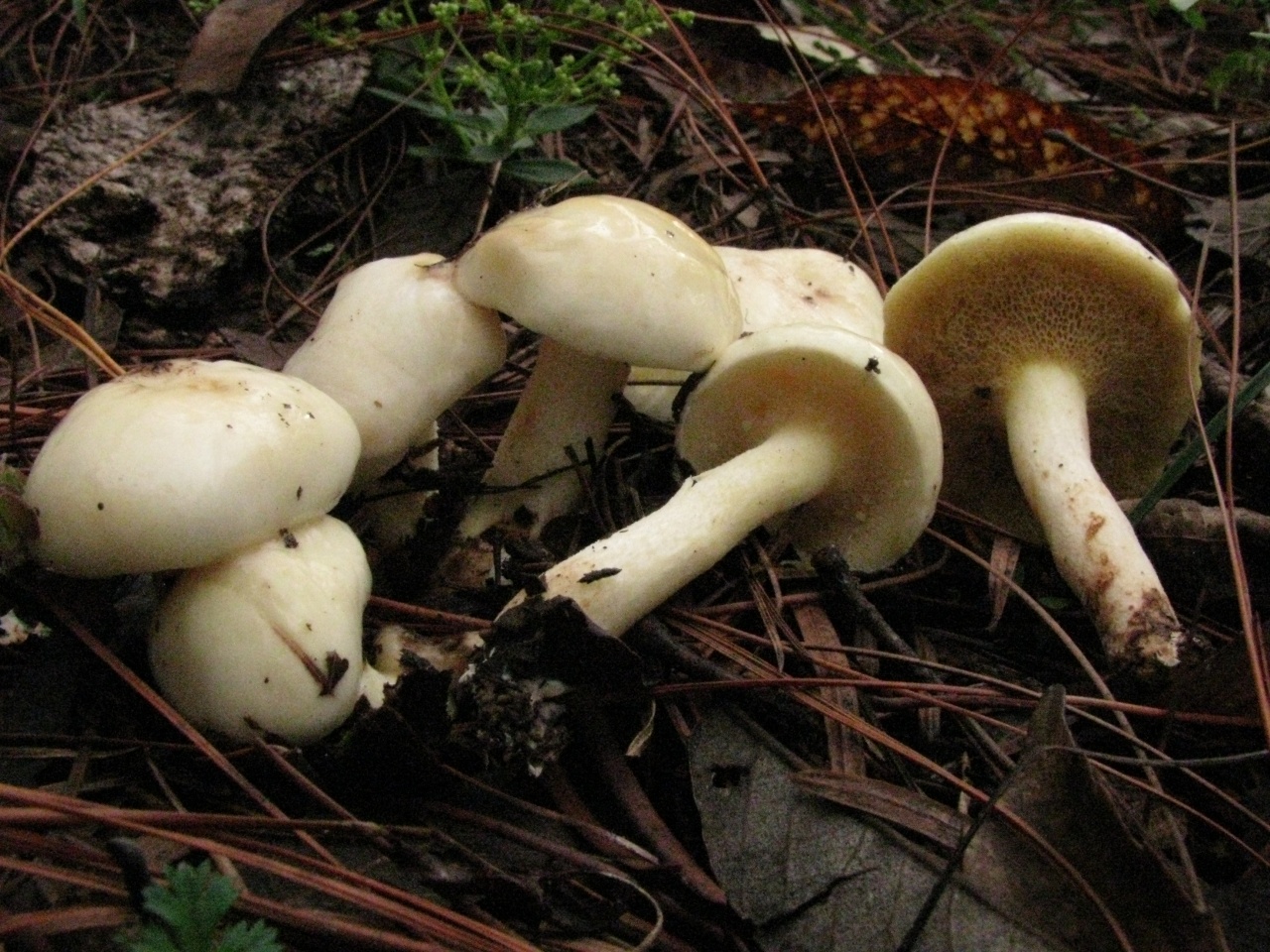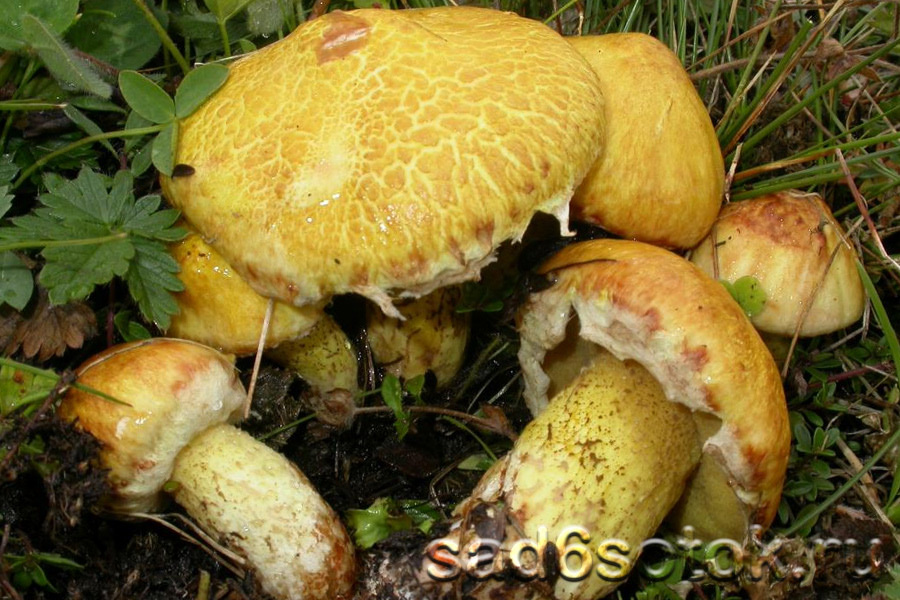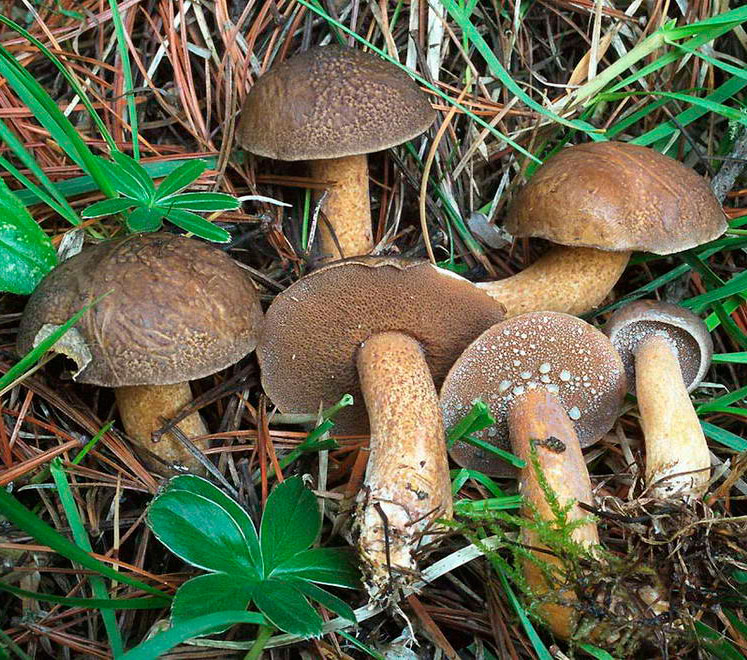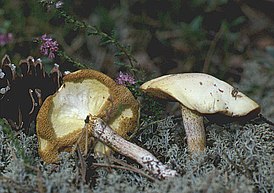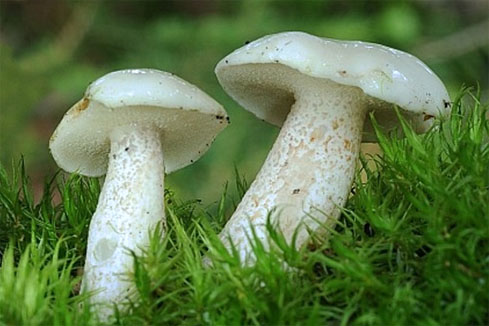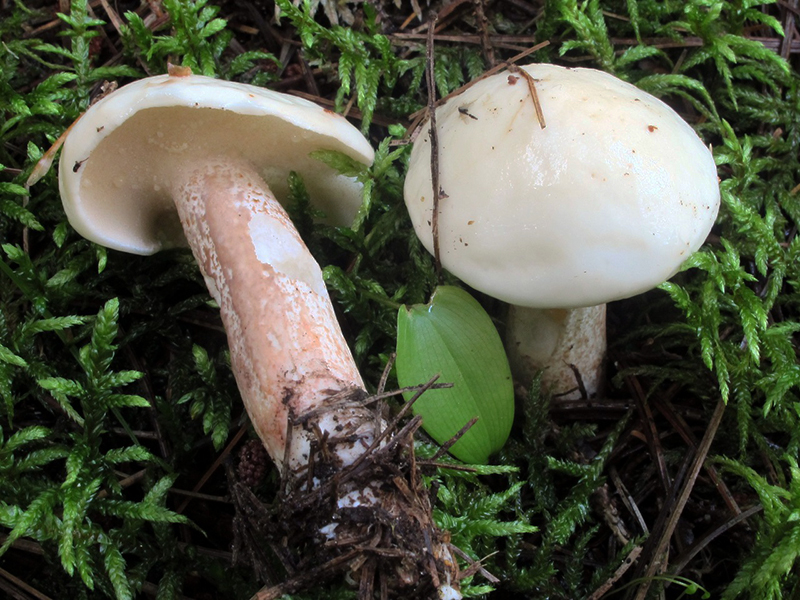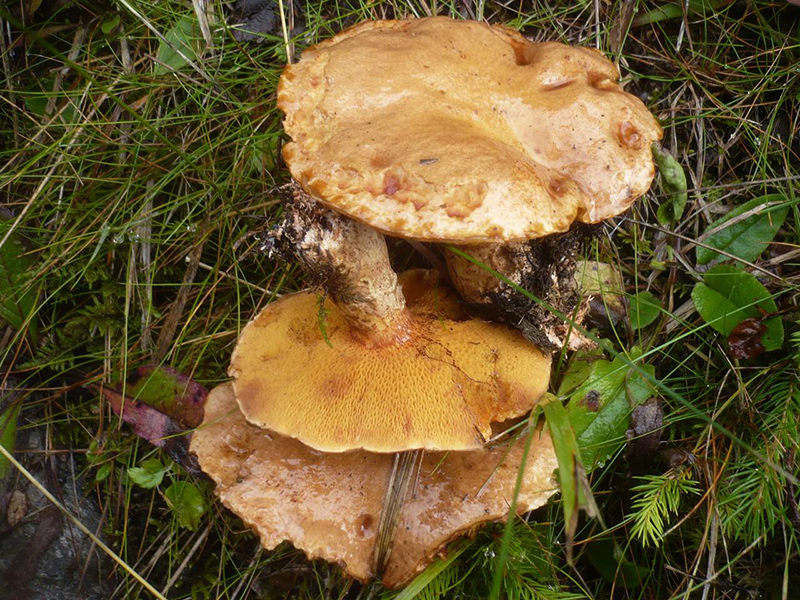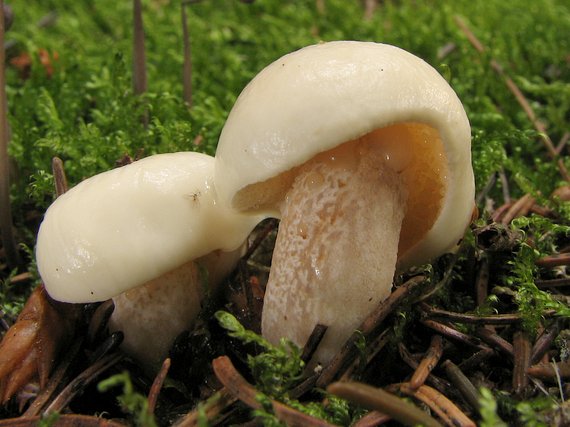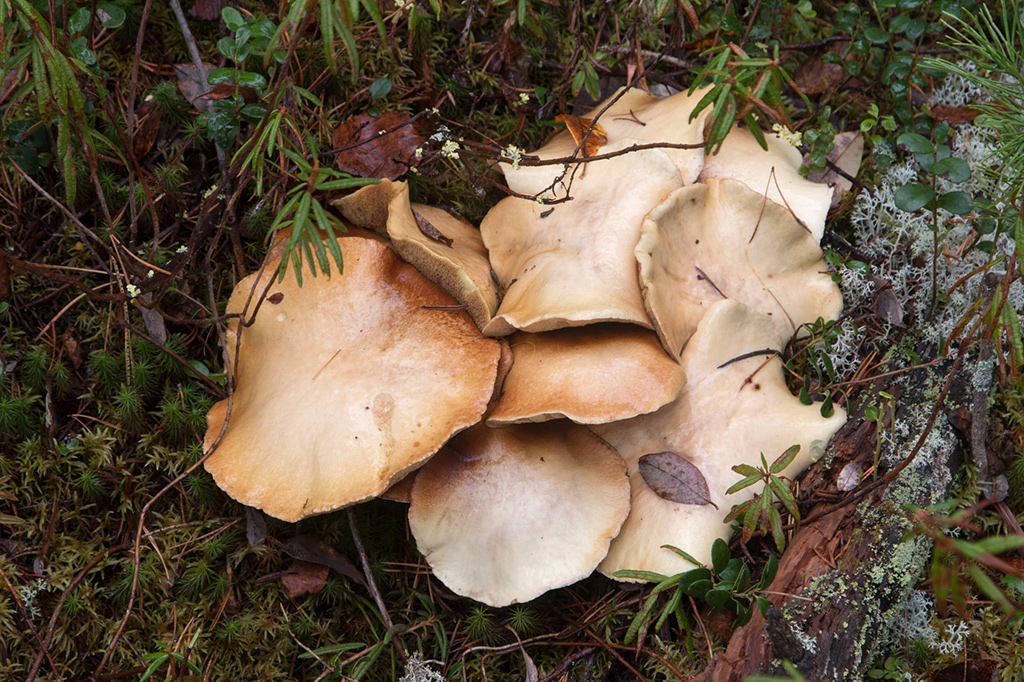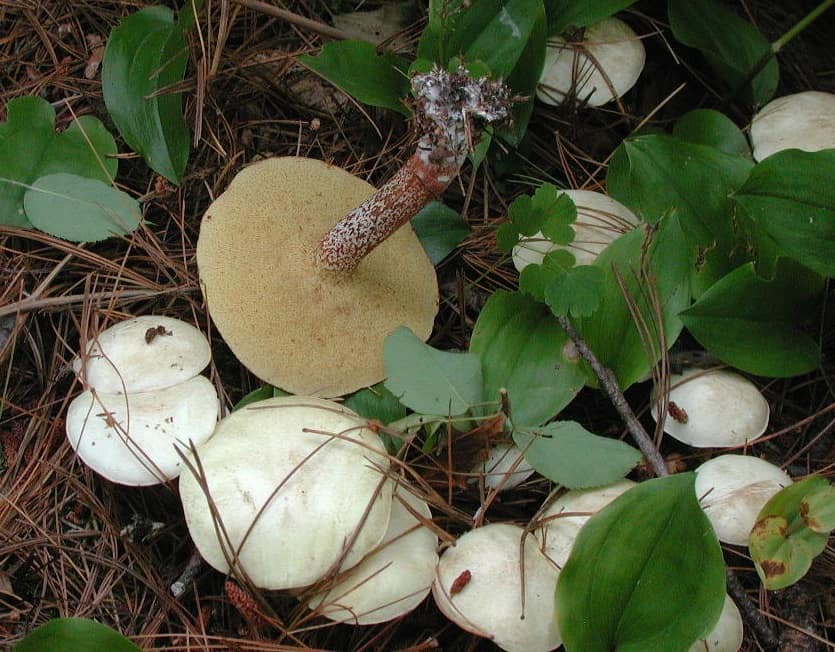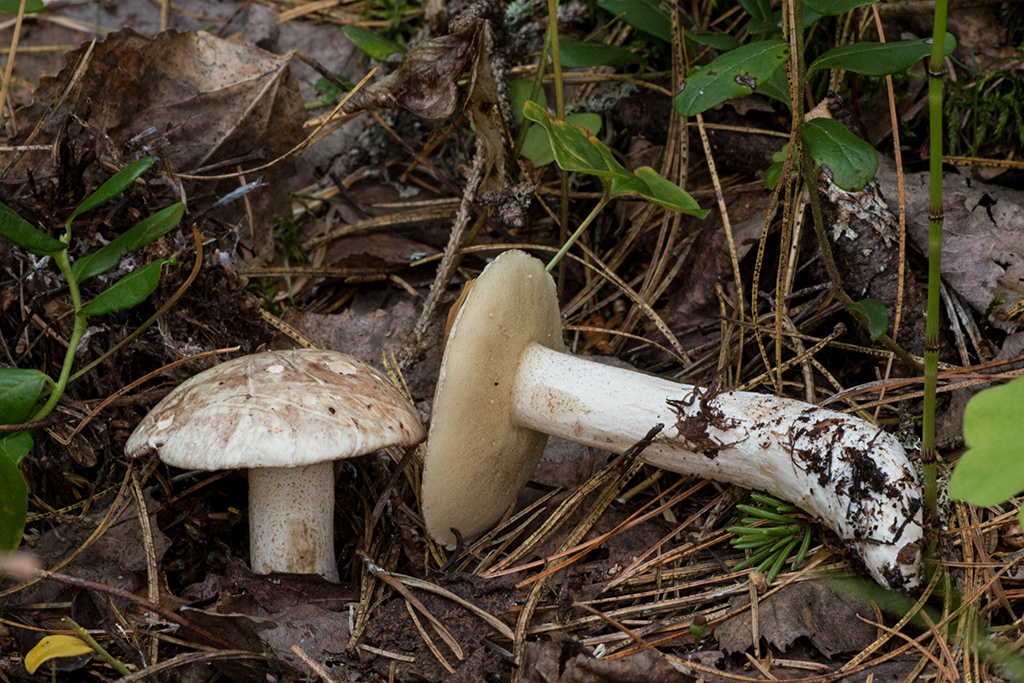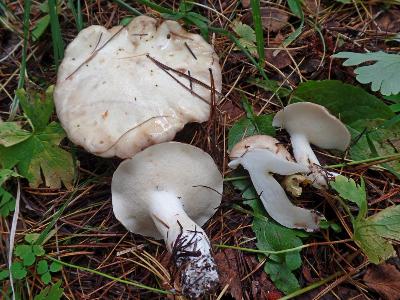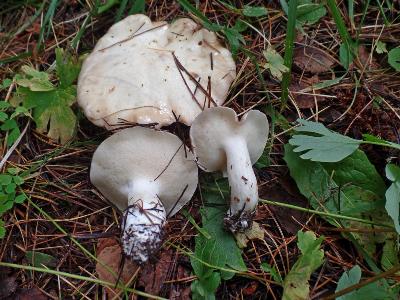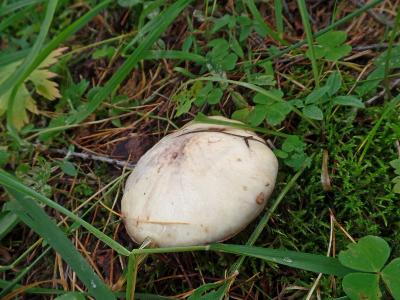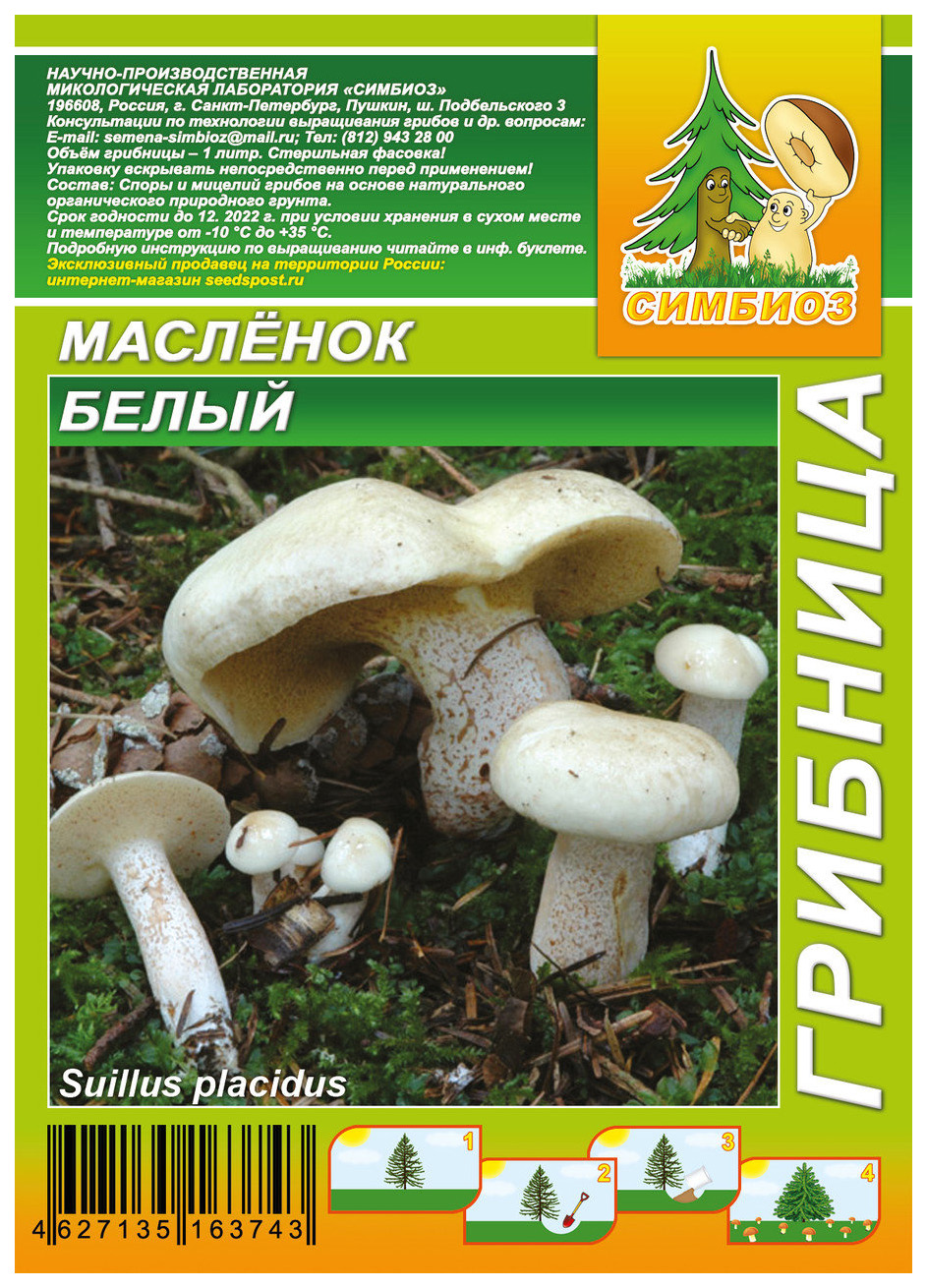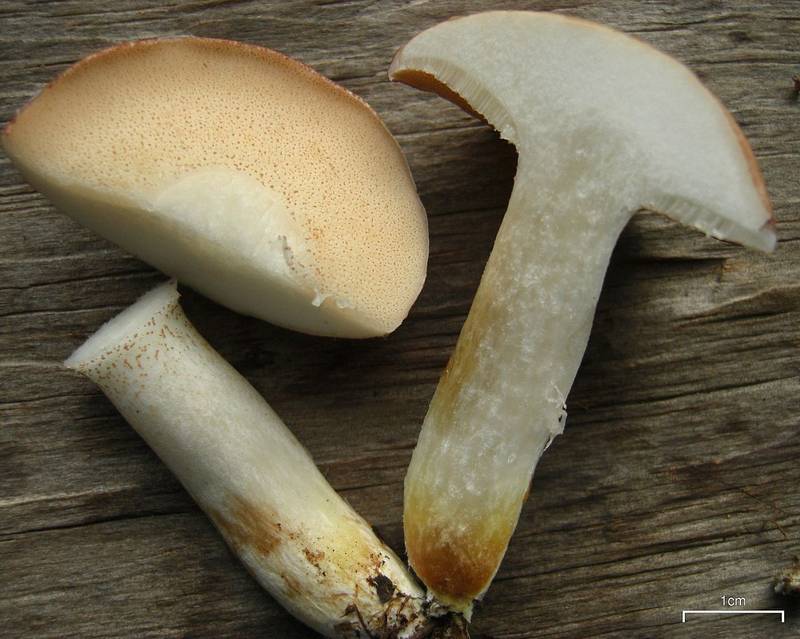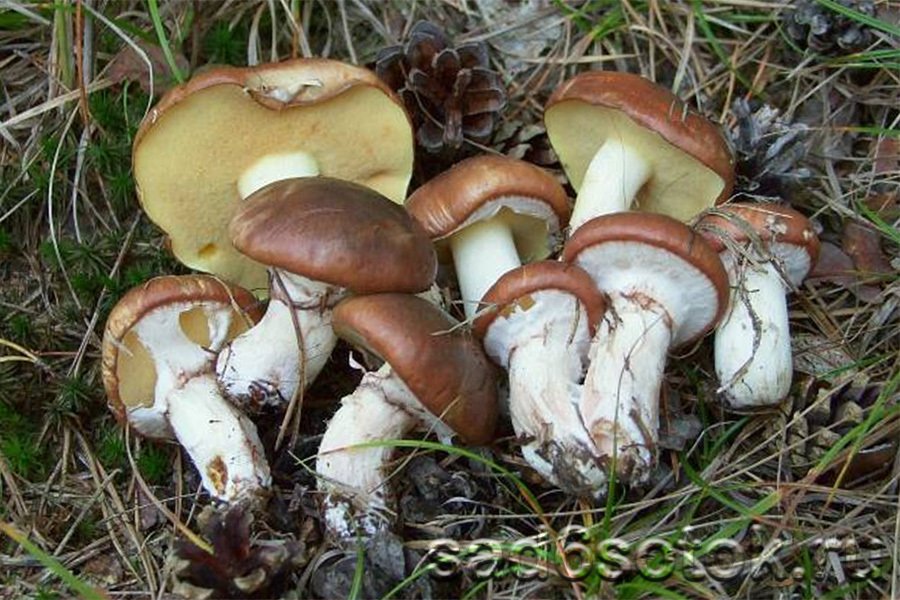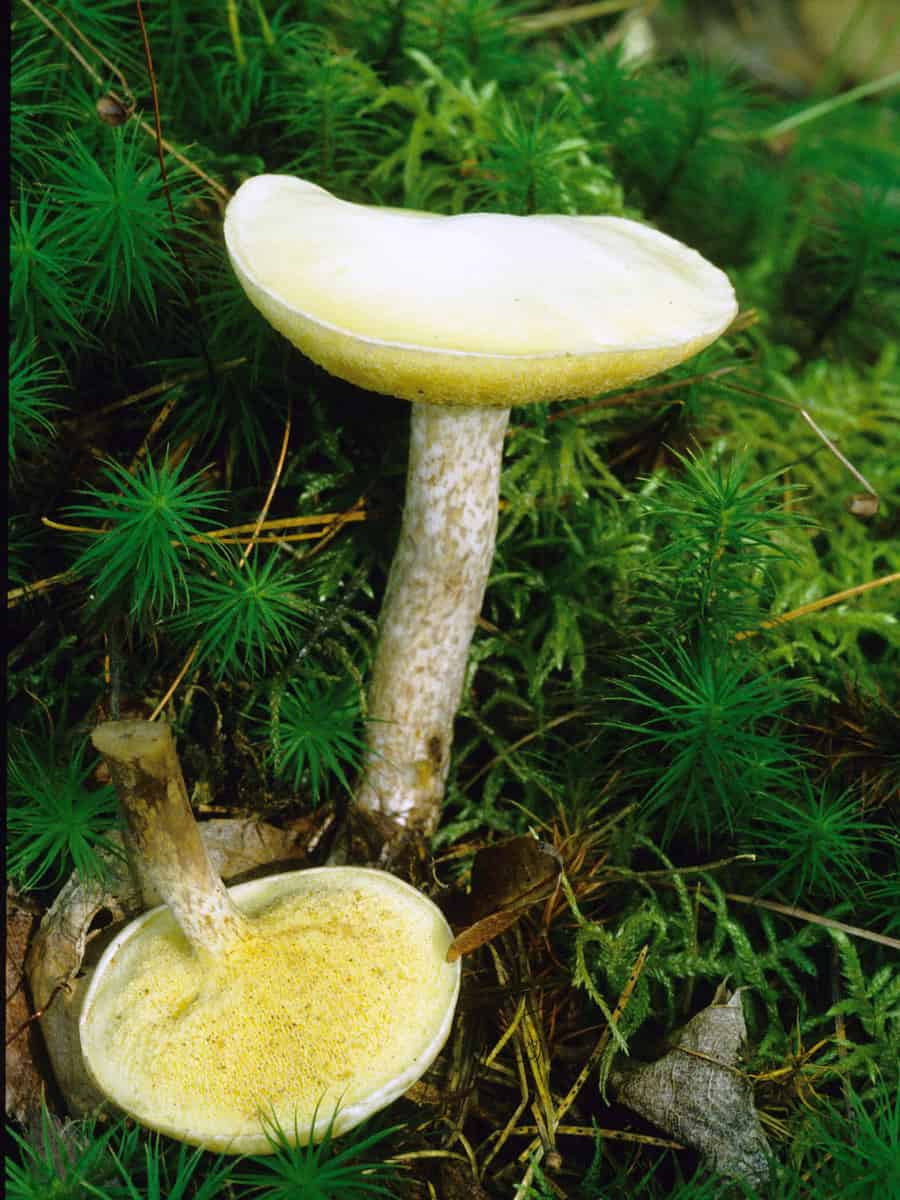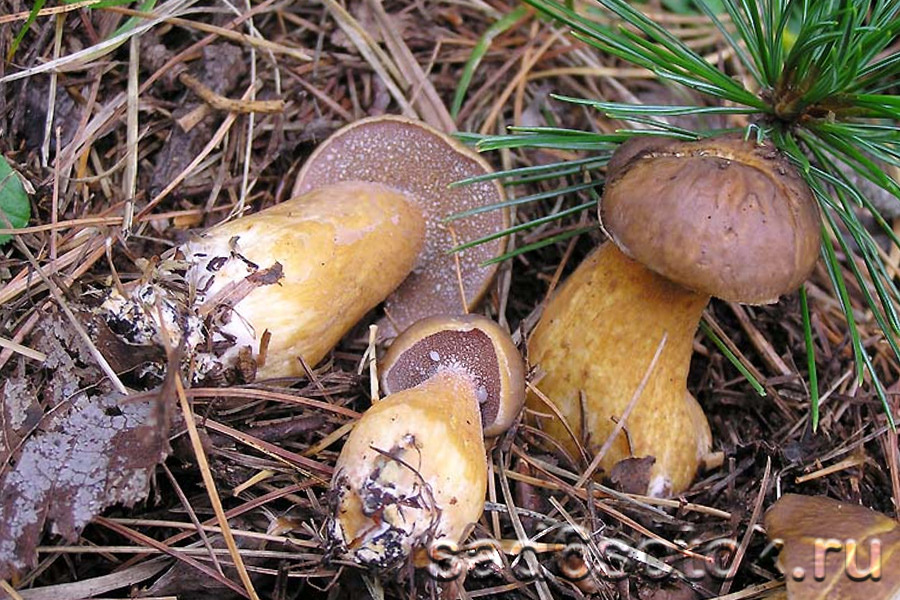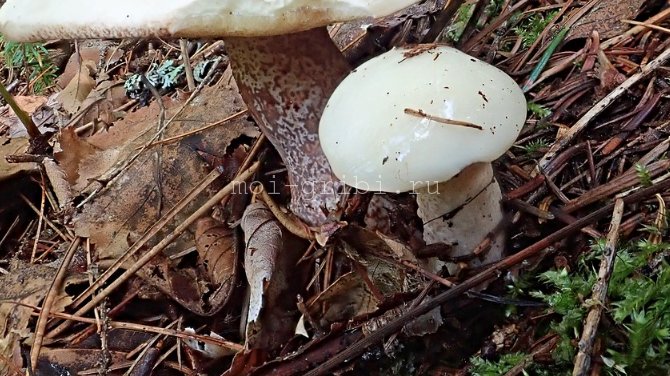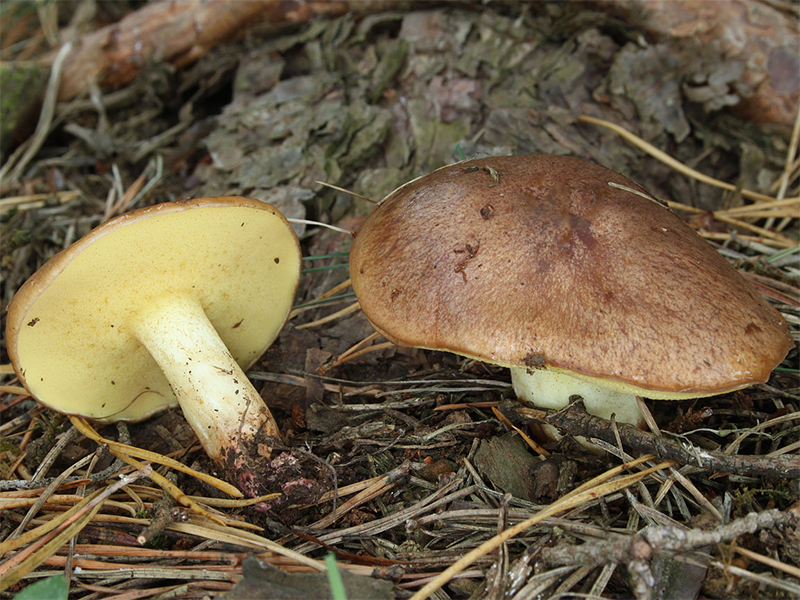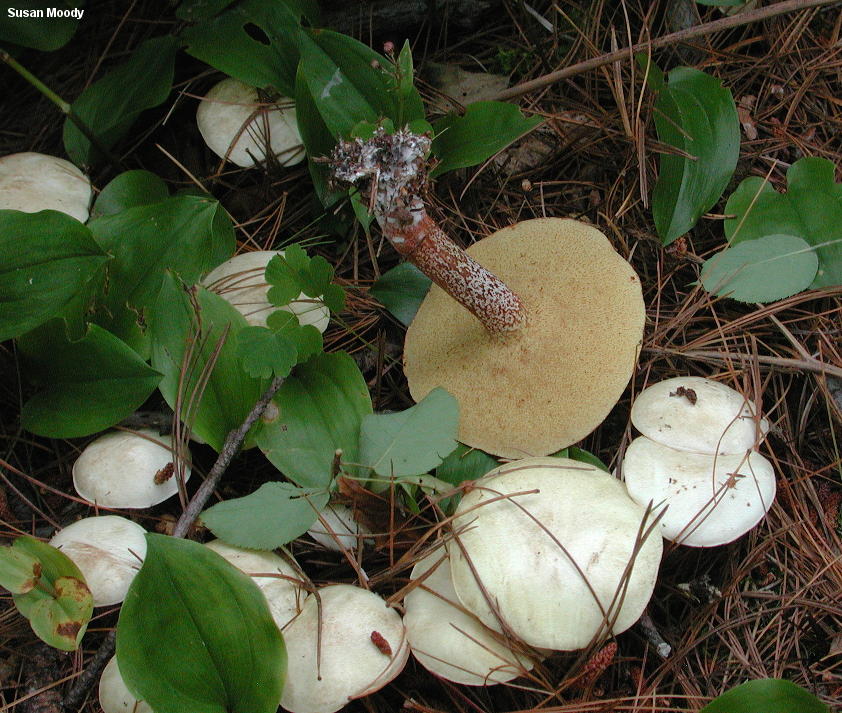Similar species
But in addition to the aforementioned types, there are also boletus, which are similar to the appearance of whites, but at the same time, they are no less useful, and even very tasty. Let's get acquainted with some representatives that vaguely resemble a white oiler, however, in one way or another, they may differ from it.
Siberian butter dish
Siberian butter dish is widespread throughout Russia. And you guessed it, mainly in Siberia.
The cap reaches 10 cm in diameter, is rather slimy and wide. Has a cushion shape. In the middle there is a small tubercle, the shade of the cap has an olive-yellow undertone. Less commonly, it is dirty yellow.
Brown-yellow fibers grow into the cap. If you look at the pulp, then it is yellow, and when heated, it practically does not change its color. The pulp is firm enough.
As for the leg, then it reaches 8 cm in length, and 2 cm in thickness. Most often it has a curved shape.
The spores have a fairly large radius, about 4 mm.
For its growth, it prefers coniferous forests, less often broad-leaved ones. Most often it enters into mycorrhiza with cedar. Harvesting is recommended between August and September. The mushroom is edible, and is very similar to white or cedar butterdish.
Cedar butter dish
The cedar butterdish is called “crying”. Let's find out why. The cap of this mushroom reaches 15 cm in diameter.
If young mushrooms are collected, then notice that their cap is rather convex, has a dome-shaped shape. However, with age, the edges begin to rise upward, which is why the cap becomes quite flat. It is on the old hat, in the cavity, that the so-called mucus begins to accumulate, which is very thick in this mushroom. By its color, the hat has a brown tint. If the weather is dry enough, it becomes glossy and dries quickly in the sun. At the same time, it quickly becomes fibrous or waxy.
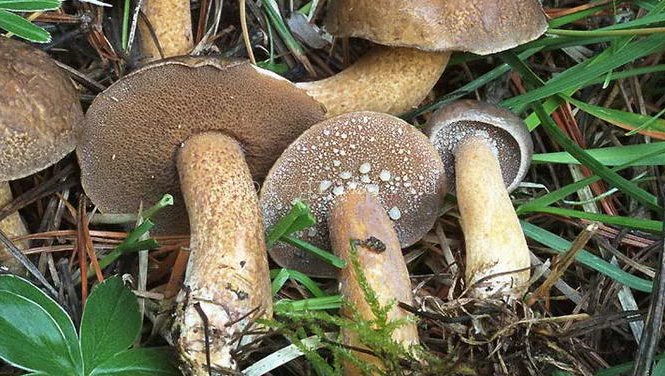
As for the pulp of this mushroom, then when broken, you can find that it has a yellowish tint, less often orange.
If you try to smell it, you will find that the mushroom has an almond aroma and tastes quite sour. At the same time, its tubes, which are located under the cap, turn brown, less often ocher-olive.
Let's look at the leg of this mushroom. It is quite high and reaches 12 cm. The same as that of a white oil can - at first it is white, and then covered with brown blotches and scales. The thickness is also similar, up to 3 cm. The base is quite thick, but tapers towards the cap. In some mushrooms, the stem is strongly curved. There is also no skirt.
It grows throughout the territory of Russia, but most of all it loves the eastern parts of its territory. Most often found in dry forests or lichens. It settles away from swamps, as it hates moisture.
The collection is carried out in August-September. It enters mycorrhiza with cedar.
Description [2]
The cap is 5-12 cm in diameter, in young mushrooms it is convex, cushion-shaped, then flattened, sometimes concave. The color of the cap of young mushrooms is whitish, pale yellow at the edges, then grayish or yellowish-white, darkening to dull olive in damp weather. The surface of the cap is smooth, bare and slightly slimy; when dry, it is shiny. The skin is easily removable.
The pulp is dense, white or yellowish, light yellow above the tubes. At the break, it slowly changes color to wine red; according to other sources, does not change color. Mushroom taste and smell, expressionless [source not specified 25 days]. In KOH, the flesh is wine-red; in ammonia it is red.
adherent to the peduncle, sometimes slightly descending. The tubules are 3-8 mm deep, whitish-yellow, later lemon-yellow, then olive-yellow, olive-brownish. The pores are small (2-4 per mm), angular-rounded, monochromatic with tubules, often with droplets of reddish liquid, usually olive-brownish at maturity from spores.
Leg 3-9 cm x 0.7-2 cm, cylindrical, sometimes fusiform towards the base, eccentric or central, often curved, solid, white, yellowish under the cap. At maturity, the surface is covered with reddish-violet-brown spots and warts, merging in places into ridges. The ring is missing.
Microstructures
Spore powder is light brownish, ocher, yellowish-olive. Spores 7-11 x 3-4 microns, ellipsoidal, fusiform-oval, smooth, hyaline, in Melzer's reagent - pale yellow, non-amyloid.
Basidia 24-28 x 6-7 microns, in KOH - hyaline, in Melzer's reagent - yellowish, clavate, two- and four-spore. Pleurocystids 49-60 x 6-9 µm, from subcylindrical to clavate, with dark brown intracellular and encrusting pigment; cheilocystids and caulocystids are similar to pleurocystids, but more capitate. The trama of the tubules is divergent. The surface of the cap is composed of narrow (3–6 µm) pale yellow hyphae. There are no buckles.
Definitioner
- Basidia (Basidia)
-
Lat. Basidia. A specialized structure of sexual reproduction in fungi, inherent only in Basidiomycetes. Basidia are terminal (end) elements of hyphae of various shapes and sizes, on which spores develop exogenously (outside).
Basidia are diverse in structure and method of attachment to hyphae.
According to the position relative to the axis of the hypha, to which they are attached, three types of basidia are distinguished:
Apical basidia are formed from the terminal cell of the hypha and are located parallel to its axis.
Pleurobasidia are formed from lateral processes and are located perpendicular to the axis of the hypha, which continues to grow and can form new processes with basidia.
Subasidia are formed from a lateral process, turned perpendicular to the axis of the hypha, which, after the formation of one basidium, stops its growth.
Based on morphology:
Holobasidia - unicellular basidia, not divided by septa (see Fig. A, D.).
Phragmobasidia are divided by transverse or vertical septa, usually into four cells (see Fig. B, C).
By type of development:
Heterobasidia consists of two parts - hypobasidia and epibasidia developing from it, with or without partitions (see Fig. C, B) (see Fig. D).
Homobasidia is not divided into hypo- and epibasidia and in all cases is considered holobasidia (Fig. A).
Basidia is the place of karyogamy, meiosis and the formation of basidiospores. Homobasidia, as a rule, is not functionally divided, and meiosis follows karyogamy in it. However, basidia can be divided into probasidia - the site of karyogamy and metabasidia - the site of meiosis. Probasidium is often a dormant spore, for example in rust fungi. In such cases, probazidia grows with metabasidia, in which meiosis occurs and on which basidiospores are formed (see Fig. E).

See Karyogamy, Meiosis, Gifa.
- Pileipellis
-
Lat. Pileipellis, skin - differentiated surface layer of the cap of agaricoid basidiomycetes. The structure of the skin in most cases differs from the inner flesh of the cap and may have a different structure. The structural features of pileipellis are often used as diagnostic features in descriptions of fungi species.
According to their structure, they are divided into four main types: cutis, trichoderma, hymeniderma and epithelium.
See Agaricoid fungi, Basidiomycete, Cutis, Trichoderma, Gimeniderm, Epithelium.
False doubles
All boletus are similar to each other, in total there are more than 50 species. The main difference between the white oil can is the red spots that cover the leg, as well as the light, almost white cap. All varieties of butter are quite tasty, there are no poisonous ones among them, but there are types with bitter pulp, although after 15 minutes of cooking, the bitterness goes away.
In the same forests where the white buttercup grows, you can find its Siberian and cedar counterparts. They should be distinguished by their hat, which is much darker. Another variety is the common or late oil can, collected in October, it grows in large families.It features a chestnut hat and a ring on the leg.
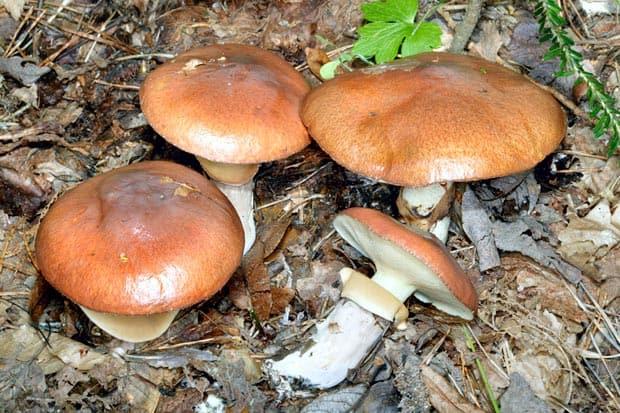 Ordinary butter dish
Ordinary butter dish
The marsh boletus is often called a double, it is not dangerous, edible, and its main difference is that it creates mycorrhiza with birches, and therefore you cannot find it next to a pine. It is also often confused with a pepper mushroom, which contains bitterness, but is not poisonous. Continuous boiling helps to get rid of the unpleasant aftertaste, then it can be fried with other mushrooms.
 Marsh boletus
Marsh boletus
False boletus and doubles
Tubular mushrooms are tasty, among them there are few inedible species, however, due to inexperience, you can put an extremely poisonous and dangerous panther fly agaric or unsuitable Siberian and pepper butter mushrooms in a basket.
Panther fly agaric (Amanita pantherina)

Panther fly agaric (Amanita pantherina)
In coniferous forests, on sandy stones, from the middle of summer to the end of autumn, the dangerous lamellar mushroom, the panther fly agaric, grows. The cap is slightly convex, up to 12 cm in diameter, brown-yellow, rarely brown. The peel of the fly agaric is covered with mucus and a scattering of whitish warty growths, which are located in centric circles or chaotically. The leg is hollow, even, with a thin ring that quickly disappears. Tuberous thickening is present at the base.
The panther fly agaric has a sharp unpleasant odor, and under the cap there are rare white plates, and the butter has a pleasant fruity aroma and a spongy tissue consisting of numerous tubes. So easily you can distinguish between these types and protect yourself from poisoning.
Siberian butter dish (Suillus sibirikus)

Siberian butter dish (Suillus sibirikus)
This inedible, but non-toxic species grows in cedar forests, which can be mistaken for a delicious cedar oil can, from which it differs in a lighter color. It can be used for food after thoroughly removing the skin and pre-boiling for at least 20 minutes.
The cap is yellow-brown or brownish-olive, up to 10 cm in diameter, convex, then flattened. The skin is slippery, the flesh is yellow, does not darken when broken. Leg up to 8 cm, creamy yellow, sometimes sulfur, with brown granularity on the skin.
Pepper Butter (Chalciporus piperatus)

Pepper oil can (Chalciporus piperatus)
Throughout the warm season, these shiny light brown mushrooms grow in small groups under the pines, less often under the spruces, successfully disguising themselves as summer and real species. The hat is convex, up to 7 cm in diameter, orange-brown or ocher, slippery in dampness, glossy in dry weather. The tubules are brown, the stem is thin, smooth, up to 11 cm high, the same color as the cap, darker at the bottom.
Both the surface of the fruiting body and the pulp are bitter, with a taste of hot pepper. One pepper mushroom, accidentally caught in a basket, is capable of ruining a future dish or preparation with its bitterness.
In what forests do boletus trees grow?
Autumn and summer oil cans grow where there are pines. Especially young
Mycologists drew attention to the fact that those pines that have two needles in each bunch are more suitable for him. Indeed, boletus often appear under the pines growing on our site.
Butters do not like strong shading, so they are less common in overgrown forests. There are more chances to collect a basket of strong butter in thinned plantings of pines, on the edges of pine forests, on the sides of forest roads and even on old fireplaces. If the oiler grew under another tree, then there is probably a pine tree nearby.
People drew attention to the fact that butter is almost never found in those pine forests where the ground is covered with white moss. They are not looked for even in pine forests with blueberries.
Wormy boletus are common. Not only big and old, but tiny too.
How to prepare oil for future use?
Butters have a sticky skin that can be easily removed. During the cleaning of mushrooms, it is certainly removed. The fingers then turn black and can be difficult to wash. A slice of fresh lemon, which is used to rub the skin of the hands, helps a lot. I saw how boletus was fried in one village.There they rinsed the mushrooms, cut them into several pieces and threw out the wormy ones. After that, they began to fry the mushrooms with the skin. Since then, I also do not always remove the skin from the oil caps.
Connoisseurs believe that the oiler is suitable for frying, drying and marinating. But this mushroom should not be salted. However, in cookbooks you can find recipes for salting butter. The best for workpieces are strong butterflies, their caps are no larger than a ring, which is formed if you connect the thumb and forefinger of one hand.
Pickled boletus
Pickled boletus is delicious. Small mushrooms are specially selected, for example, the size of a three-kopeck coin. They are pickled whole. Pickled butter is difficult to catch with a fork. This is "aerobatics", the result of the skill of a mushroom picker and a culinary specialist. More often, you have to cook not tiny, but different sizes of boletus, which were collected in the forest.
First of all, the boletus is cleaned, the film and skin are removed from the caps. It is believed to give bitterness. Oil hats are cut in half or into several parts. For medium-sized mushrooms, it is better to separate the stem. After that, the mushrooms are washed and boiled in water, which was previously slightly salted and acidified with 9% table vinegar. The foam must be removed. In about fifteen minutes the boletus will begin to sink to the bottom. The cooking is stopped. Mushrooms are thrown into a colander, cooled, laid out in glass jars, garlic cloves are added and poured with marinade.
Marinade is very simple to prepare. To do this, dissolve 4 tablespoons of salt, 2 tablespoons of sugar in one liter of boiling water, add spices (bay leaves, cloves, allspice, cinnamon or ready-made seasoning for pickling mushrooms), increase the gas and boil the liquid for several minutes. After that, remove the pan from the stove and pour 3-4 tablespoons of 9% vinegar into the marinade. The oil is poured with cooled marinade. It should cover all the mushrooms. Pour vegetable oil on top so that there is no mold. It is safer to use nylon (plastic) lids, and keep the jars in the refrigerator. Tins rolled up with metal lids are stored in a cool place, such as a refrigerator. They must be opened before the New Year. The shorter the shelf life, the less likely you are to get botulism.
Canned fried boletus
V.A. Soloukhin, an excellent writer, nature connoisseur and mushroom picker, described an interesting way of preserving fried butter. He learned this recipe from M.I. Tvardovskaya.
Mushroom cutlets
This is a very tasty and satisfying food. Butter pulp is suitable for cooking cutlets using mushrooms instead of meat. First, the butter is boiled for ten minutes. Then the water is poured into another dish and white bread is soaked in it. Minced meat is made from mushrooms, soaked bread and onions, passing everything through a meat grinder. Eggs, flour (if necessary) and salt (to taste) are added to the minced meat. It is advisable to introduce finely chopped parsley or other herbs. Cutlets are formed from minced meat, which are rolled in breadcrumbs and fried in vegetable oil under a lid. Food ratios may vary.
Podmoskovye website, 2012-2019. Copying texts and photos from the site pоdmoskоvje.cоm is prohibited. All rights reserved.
Edible oil can of the present
Buttercup yellow, like other representatives of this genus, is an edible mushroom. Therefore, you should not have any doubts about how much this mushroom can be eaten.
Yellow butter dish is good in any form, and stewed, pickled and fried.
This mushroom is absolutely not dangerous, however, you should not collect in your basket those representatives of the genus that grow along the highways close to dangerous enterprises. Although butter oil is absolutely safe for human health, unfortunately, it absorbs toxins and toxins that spread around. Because of this, this can lead to minor stomach and intestinal problems.
This mushroom is delicious and belongs to the second category.If we compare its taste with other mushrooms, then it is closest to white ones. Before eating it, it is recommended to remove the skin from the cap, since it contained mucus, which means that most likely there were numerous insects.
This mushroom is easily digestible, so it is included in numerous diets, and is also a good dietary product.
Perfect for preparing side dishes, soups, good with meat and as a sauce.
Calorie content
As mentioned above, yellow oil can easily be called a mushroom, which is a dietary one. In dried form, it is sold in many countries around the world, and is eaten as a separate product.
The yellow oil can taste very pleasant. Therefore, in recent years, having studied the beneficial properties of this mushroom, it is suggested to be eaten by people who are on a diet.
Considering that this mushroom is absolutely not high in calories, it will not cause problems for your figure. So, 100 g of mushrooms contains only 60 calories. The main part goes to proteins, a little less to carbohydrates, and a very minimal amount of calories goes to fats. Therefore, even the daily use of oil will not be harmful. However, this mushroom contains a lot of useful elements that have a positive effect on human health. For example, it contains vitamins A, B, Omega, as well as minerals and substances that have a positive effect on immunity.
Delicious boletus and their inedible counterparts
Does the oiler have inedible or poisonous counterparts? The usual types of butter are delicious mushrooms. They have a characteristic cap. Only a yellow-brown butter dish with slightly blue flesh on the cut can disappoint gourmets because of its mediocre taste. Some Western guides define it as inedible (but not poisonous!). Siberian butterdish is also considered a non-toxic inedible mushroom.
There are no poisonous oils in our forests. But it is quite possible to confuse a delicious butter dish with a pepper mushroom (Suillus piperatus). This mushroom is called: pepper oil can. It contains bitterness but is not poisonous. Mushroom pickers who put pepper oil cans in the basket say in their own defense that the bitter taste is greatly reduced when boiled for 15 minutes. After that, the mushroom is fried along with other mushrooms. Pepper can grow not only next to pine trees, but also in spruce and deciduous forests.
Ordinary butter dish
Common butter dish (Suillus luteus)
Common butter dish (Suillus luteus)
It is also popularly called late oiler, yellow oiler, real oiler, autumn oiler.
One of the most common and beloved mushrooms. Grows in pine forests, in young stands. Found in mixed pine-birch and pine-oak forests. In relation to light, it is not whimsical, it can grow both in darkened areas of the forest, and on the edges of the forest, in small bright glades, along the sides of roads. You can find it, as a rule, under fallen pine needles or leaves. Prefers sandy soil. In highly humid places, in swamps, near lakes or peat bogs, the common oiler does not grow.
The hat is 5-12 cm. There are also large sizes. At first it has a rounded, hemispherical shape. The cap of an ordinary oiler is painted in a dirty yellow or brownish color. Over time, the cap straightens out, and becomes flat-convex and finally, almost completely flat. When ripe, the color of the cap also changes. It turns dark brown, chocolate brown. Sometimes reddish brown or reddish brown. To the touch, the cap is smooth, covered with mucus. The skin covering the body of the cap is easily peeled off. The pulp is firm, but soft, fleshy. White or slightly yellowish. The tubular layer adhered to the stem is at first light, then turns yellow, and in mature mushrooms it is olive yellow. The pores are round, small.
The leg of an ordinary oiler is short. Reaches a length of 4-9 cm (sometimes up to 12). It has a cylindrical shape. The pulp of the leg is fibrous, solid.In young butter, the edges of the cap are connected to the stem by a thin, white film. As it grows, the cap straightens, the film breaks, as a result of which a light ring forms on the stem. Above the ring, the leg is white. The rest is colored yellow or off-yellow.
The growing season for this mushroom lasts from mid-summer until the first autumn frosts. As soon as the temperature drops and becomes minus on the surface of the soil, the ordinary oiler stops bearing fruit. Massively begins to bear fruit in the month of September. It usually appears on the second or third day after rain. The optimum temperature for fruiting is 15-20 degrees. He loves friendly companies, so he grows in groups. Does not reject neighbors such as chanterelles, porcini mushrooms, russula. In the summer, it is especially susceptible to damage by pests (worms, insect larvae). Therefore, in the summer, you should not wait for its ripening. It is possible and even necessary to collect them at a young age, when the hat has not yet opened. At this age, ordinary oiler is considered the most delicious.
But, in spite of this, the ordinary oiler is one of the most common and everyone's favorite mushrooms. In some countries, they are engaged in artificial breeding of these boletus.
Oiler ordinary photo
Butter dish (Suillus luteus) Butter dish (Suillus luteus) Butter dish (Suillus luteus)
Granular oiler
Granular butter dish (Suillus granulatus)
Granular butter dish (Suillus granulatus)
This mushroom is also called a summer oil can, an early oil can. Its usual habitat is thinned pine forests, young plantings, clearings, glades, edges. It can be found in coniferous forests, with the presence of pine. Loves sandy and calcareous soils. A fairly common mushroom.
The cap of a granular oiler reaches up to 10 cm in size, in mature mushrooms. At an early age, its shape has a rounded-convex, pillow-like shape. Over time, as it grows, it straightens out, and becomes almost flat in adulthood. The color of the skin of the cap of a granular oiler varies from yellow-brown to chestnut or red-brown. The skin is smooth, mucous to the touch in rainy or wet weather. It becomes shiny in dry weather. The skin is thin and easily removed from the cap. The pulp is elastic, soft. On the cut, it is first white, over time the color changes and turns slightly yellow. Almost odorless.
Tubular layer adhered to the cap. The tubules are short, finely porous. At a young age, light yellow in color, over time they become dirty yellow, sometimes with a greenish tinge. In damp weather, droplets of a white, sticky liquid are released. The pores are light yellow, roundish, small. Over time, the color changes to a dirty yellow. The size and shape are also changing. The pores become larger (sometimes up to 1 mm) and uneven.
A characteristic feature of a granular oiler is the absence of a ring on its stem. The leg is solid, cylindrical, smooth, falling, white liquid from the tubular layer falls on the leg and dries there, forming brown granularity in its upper part. Stem sizes can reach 6-8 cm in mature mushrooms. The color changes from light yellow at an early age to yellow-brown in old age. The pulp is firm, white or light yellow in color. When cut, as a rule, the color does not change. Granular oiler belongs to the second category of mushrooms. Usually grows in small groups. In rare cases, singly. You can recognize it by the peculiar graininess in the upper part of the leg and the absence of a ring on it, as well as by the liquid released in the lower part of the cap. The growing season is early summer (June) and until November. It is used in food in any form. A very tasty and healthy mushroom.
Butter dish white

The cap of the white oiler is 5-12 cm in diameter, in young mushrooms it is convex, cushion-shaped, then flattened, sometimes concave. The color of the cap of young mushrooms is whitish, pale yellow at the edges, then grayish or yellowish-white, darkening to dull olive in damp weather.The surface of the cap is smooth, bare and slightly slimy; when dry, it is shiny. The skin is easily removable.
The flesh of the butter dish is white, dense, white or yellowish, light yellow above the tubes. At the break, it slowly changes color to wine red; according to other sources, does not change color. Mushroom taste and smell, expressionless.

The leg of the oiler is white, 3-9 cm x 0.7-2 cm, cylindrical, sometimes fusiform towards the base, eccentric or central, often curved, solid, white, yellowish under the cap. At maturity, the surface is covered with reddish-violet-brown spots and warts, merging in places into ridges. The ring is missing.
All almost white; leg without ring, usually with reddish or brown warts, almost merging into ridges. Grows with five-coniferous pines.
Similar species The white cap, the reddish-spotted stem, and the lack of a blanket, combined with its proximity to pine trees, makes this species easily recognizable. The Siberian oiler (Suillus sibiricus) and the Siberian cedar oillet (Suillus plorans) found in the same places are noticeably darker in color.
The edible marsh boletus (Leccinum holopus), a rare fungus that forms mycorrhiza with birches, is also mentioned as a similar fungus. In the latter, the color in the mature state acquires a greenish or bluish tint.
An edible but minor mushroom. Suitable for food fresh, pickled and salted. Only young fruiting bodies are harvested, which should be cooked immediately, because their flesh quickly begins to rot.
The edible mushroom is also mentioned as a similar mushroom.
False doubles
Novice mushroom pickers can confuse the flywheel with other species. The difference is especially clear in the photo.
Goat. The main difference from the variegated oiler is its more impressive dimensions. The hat is much lighter in color. The color of the tubular layer is straw brown or olive red.
Cedar butter dish
Goat
- Cedar punctate oiler. The cap of this mushroom is always sticky, and the stem is covered with warty white growths that darken as they grow older. At the break, the pulp does not turn blue.
-
Fractured flywheel. The hat surface of an adult fetus cracks as it grows and unfolds. When cut, the body turns blue, but then becomes purple in color. The leg at the point of attachment to the cap is always with a slight reddening.
- The slender pig in some growth stages is very similar to the variegated oiler. It is very simple to distinguish it - the lamellar hymenophore.
-
The flywheel is red. The stem and cap of this mushroom has a characteristic reddish-ocher color. The pulp is firm and yellow, turns blue when cut.
All the species described are edible, have a characteristic mushroom smell, and only the swamp smells like pine needles.
When collecting a variegated oil can in the forest, you should be extremely careful, because it also has many doubles, the use of which is dangerous for humans.
| Name | Specific traits | Differences |
| Wood flywheel | Rounded reddish-brown cap, the skin cannot be removed. Curved leg in the same shade. The pulp is odorless. | Grows on a tree body: stumps, tree trunks, sawdust. |
| Mokruha spruce | The fruit body is lamellar, the cap is brown. | Mucous covering of the cap. A skirt with a leg. |
| Siberian boletus | Pale yellow convex cap, blushes with age. | On the cut, lilac brown. The leg is curved in small spots. |
A false flywheel is put into a separate category. It has no nutritional value or health hazard, but tastes disgusting. The size is half the size of the marsh. Likes to grow on the mycelium of false raincoats.

